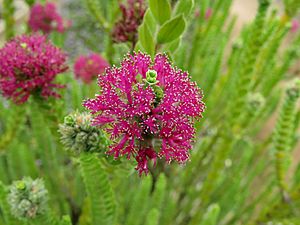Regelia megacephala facts for kids
Quick facts for kids Regelia megacephala |
|
|---|---|
 |
|
| R. megacephala inflorescence in Royal Botanic Gardens, Cranbourne | |
| Conservation status | |
| Scientific classification | |
| Genus: |
Regelia
|
| Species: |
megacephala
|
| Synonyms | |
|
Melaleuca gardneri Craven & R.D.Edwards |
|
Regelia megacephala is a special plant that belongs to the Myrtaceae family, also known as the myrtle family. This plant is only found in the south-west part of Western Australia. It is taller than other plants in its group, growing as a shrub with small, round leaves. From October to December, it shows off pretty purplish-red flowers.
Contents
What Regelia megacephala Looks Like
Regelia megacephala is a shrub that grows upright and can look a bit messy. It usually reaches a height of about 2 to 5 meters (6.5 to 16 feet). Its leaves are small and grow in a unique way. They are arranged in pairs, with each pair at a right angle to the one below it. This makes the leaves form four neat rows along the plant's long stems.
The flowers of this plant are a lovely mauve color. They grow in tight, round clusters, about 15 millimeters (0.6 inches) across. These flower clusters appear at the ends of long stems. Even after the flowers bloom, these stems keep growing. Each flower has 5 sepals, 5 petals, and 5 groups of stamens. The plant flowers from September to December. After the flowers fade, they turn into woody seed pods called capsules.
How Regelia megacephala Got Its Name
The plant Regelia megacephala was first officially described in 1964. This was done by an Australian plant expert named Charles Gardner. He wrote about it in a scientific paper called Journal of the Royal Society of Western Australia.
The second part of its scientific name, megacephala, is a Greek word. It means "large-headed," which likely refers to its noticeable flower clusters.
Where Regelia megacephala Grows
Regelia megacephala likes to grow in red sand. You can find it on rocky hills made of a type of rock called quartzite. These areas are located in the Avon Wheatbelt and Swan Coastal Plain regions of Western Australia.
This plant often grows near a special type of rock called Coomberdale chert. This chert is dug up from the ground to make silicon. Because of this mining activity, the places where Regelia megacephala lives are at risk.
Protecting Regelia megacephala
The government of Western Australia lists Regelia megacephala as "Priority Four" flora. This means that the plant is rare or close to becoming threatened. The Department of Parks and Wildlife keeps an eye on these plants to help protect them.
Using Regelia megacephala in Gardens
Regelia megacephala is not a common plant to see in home gardens. However, it is quite tough. It can handle frost and grows well in sunny or partly sunny spots. Its tall, narrow shape makes it a good choice for smaller gardens. People have even looked into whether it could be grown and sold as a special Christmas flower.


